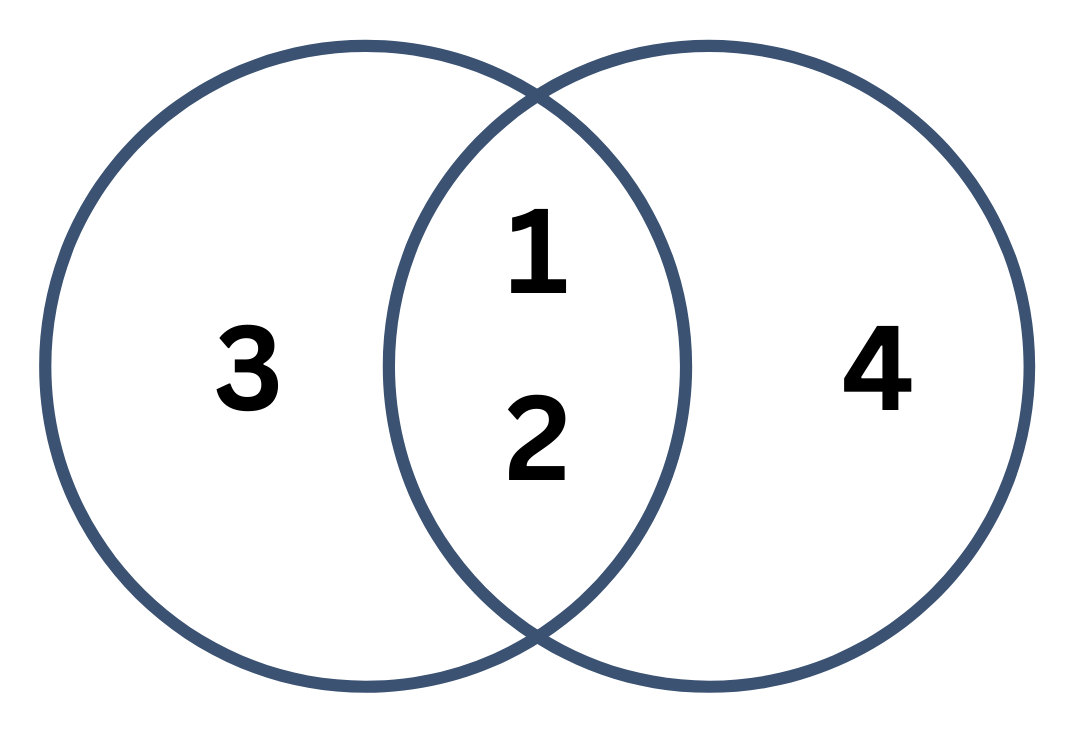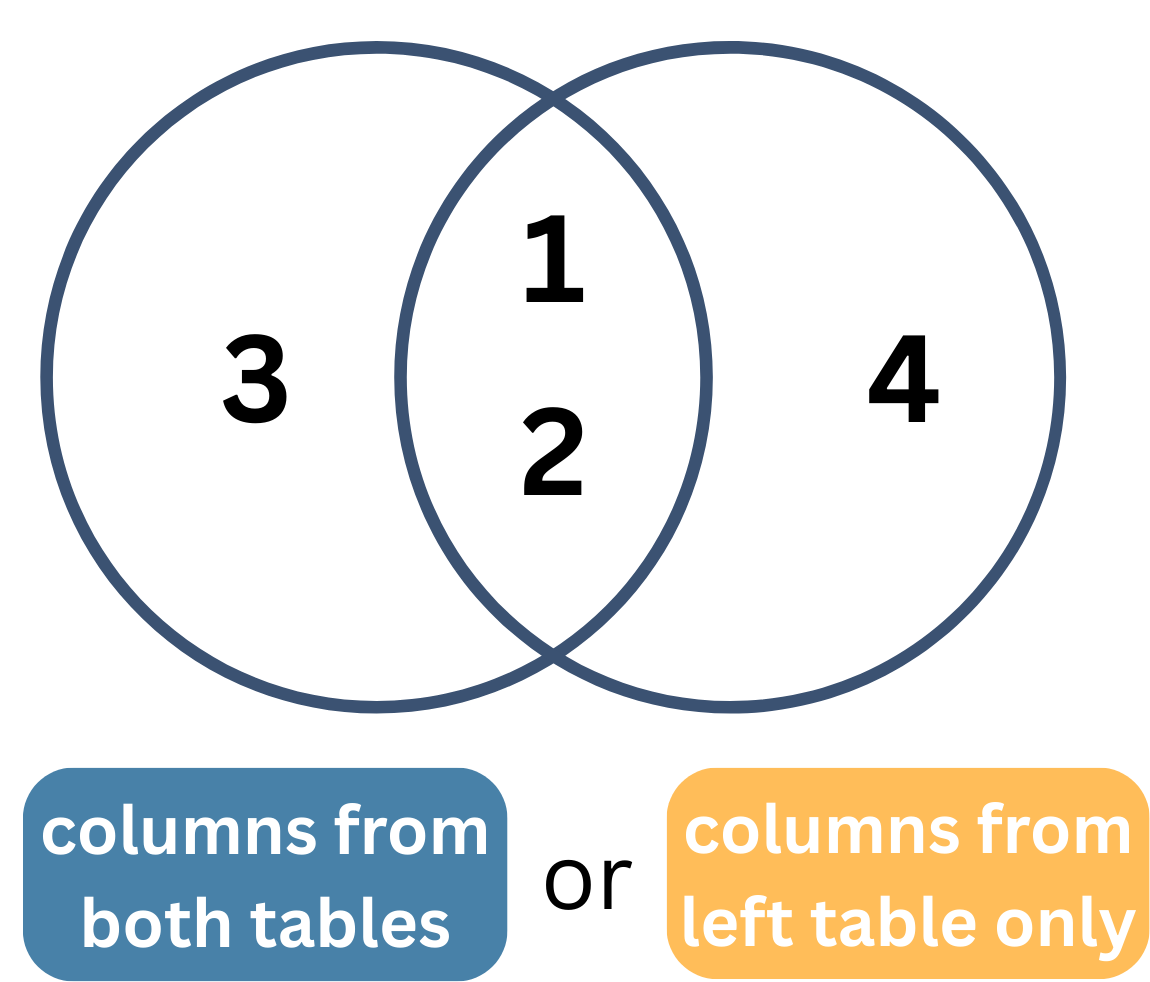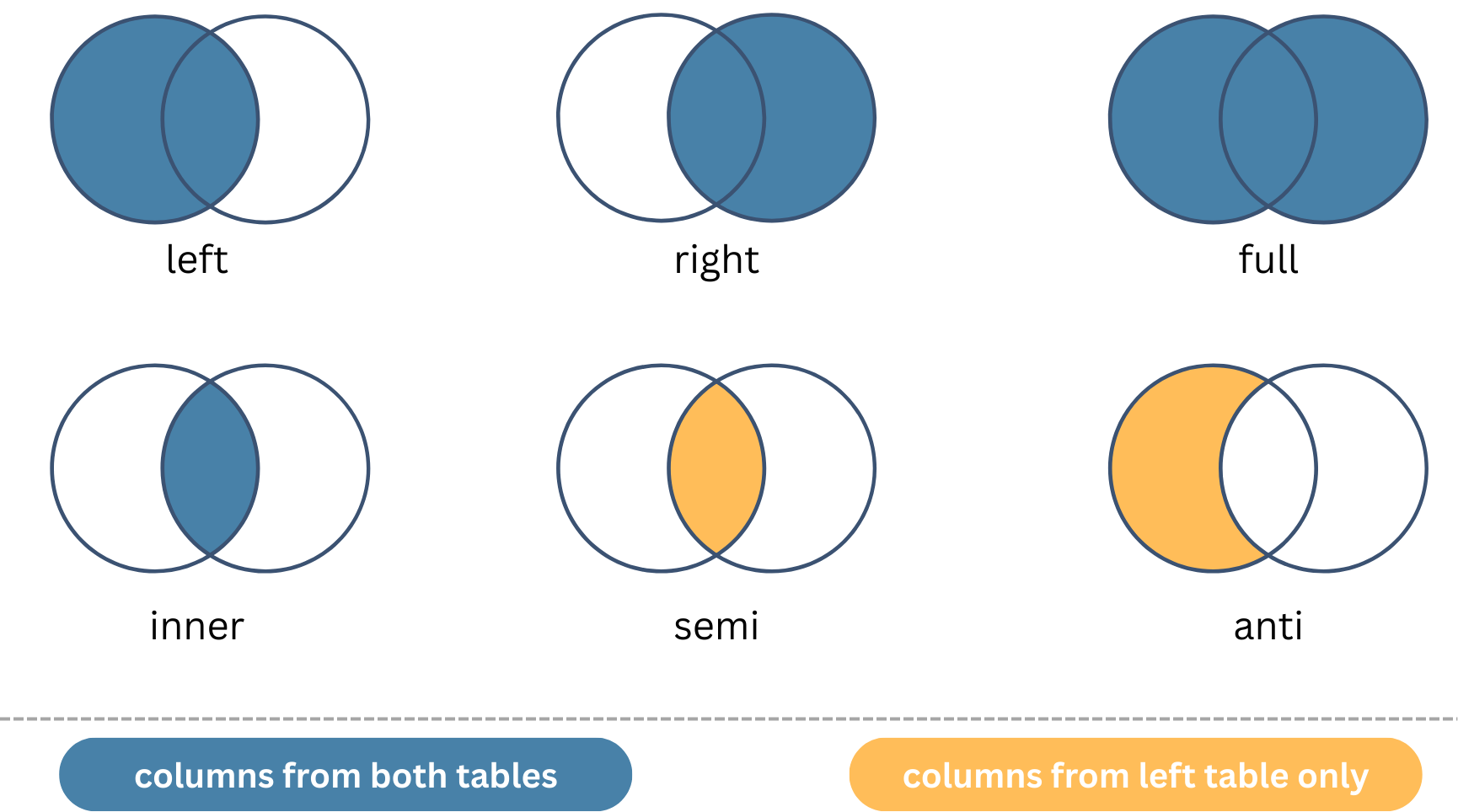# A tibble: 5 × 3
C1 C2 C3
<chr> <chr> <int>
1 A X 1
2 A Y 2
3 A X 3
4 B X 4
5 B Y 5Midterm Review
Lecture 11
Announcements
- Office hours today from 1:00-3:00.
- Be in class and lab on Monday!!!!
Review
-
group_by/summarize/mutate - joins
- pivots
Computing summary stats
With summarize: condenses information into smaller result table
With mutate: adds a new column to the data
With groupby: results for each provided group
Sample Data
Mutate vs. Summarize
Compute the mean of C3.
df# A tibble: 5 × 3
C1 C2 C3
<chr> <chr> <int>
1 A X 1
2 A Y 2
3 A X 3
4 B X 4
5 B Y 5df |>
mutate(mean_3 = mean(C3))# A tibble: 5 × 4
C1 C2 C3 mean_3
<chr> <chr> <int> <dbl>
1 A X 1 3
2 A Y 2 3
3 A X 3 3
4 B X 4 3
5 B Y 5 3Mutate vs. Summarize
Compute the mean of C3.
Grouping
Group by C1.
df# A tibble: 5 × 3
C1 C2 C3
<chr> <chr> <int>
1 A X 1
2 A Y 2
3 A X 3
4 B X 4
5 B Y 5df |>
group_by(C1)# A tibble: 5 × 3
# Groups: C1 [2]
C1 C2 C3
<chr> <chr> <int>
1 A X 1
2 A Y 2
3 A X 3
4 B X 4
5 B Y 5Grouping
Group by C1 and C2.
df# A tibble: 5 × 3
C1 C2 C3
<chr> <chr> <int>
1 A X 1
2 A Y 2
3 A X 3
4 B X 4
5 B Y 5df |>
group_by(C1, C2)# A tibble: 5 × 3
# Groups: C1, C2 [4]
C1 C2 C3
<chr> <chr> <int>
1 A X 1
2 A Y 2
3 A X 3
4 B X 4
5 B Y 5Mutate vs. Summarize (with grouping)
Compute the mean of C3 by value of C1.
df# A tibble: 5 × 3
C1 C2 C3
<chr> <chr> <int>
1 A X 1
2 A Y 2
3 A X 3
4 B X 4
5 B Y 5df |>
group_by(C1) |>
mutate(mean_3 = mean(C3))# A tibble: 5 × 4
# Groups: C1 [2]
C1 C2 C3 mean_3
<chr> <chr> <int> <dbl>
1 A X 1 2
2 A Y 2 2
3 A X 3 2
4 B X 4 4.5
5 B Y 5 4.5Mutate vs. Summarize (with grouping)
Compute the mean of C3 by value of C1.
df# A tibble: 5 × 3
C1 C2 C3
<chr> <chr> <int>
1 A X 1
2 A Y 2
3 A X 3
4 B X 4
5 B Y 5df |>
group_by(C1) |>
mutate(mean_3 = mean(C3))# A tibble: 5 × 4
# Groups: C1 [2]
C1 C2 C3 mean_3
<chr> <chr> <int> <dbl>
1 A X 1 2
2 A Y 2 2
3 A X 3 2
4 B X 4 4.5
5 B Y 5 4.5df |>
group_by(C1) |>
summarise(mean_3 = mean(C3))# A tibble: 2 × 2
C1 mean_3
<chr> <dbl>
1 A 2
2 B 4.5Mutate vs. Summarize (with grouping)
Compute the mean of C3 by value of C1 and C2.
df# A tibble: 5 × 3
C1 C2 C3
<chr> <chr> <int>
1 A X 1
2 A Y 2
3 A X 3
4 B X 4
5 B Y 5df |>
group_by(C1, C2) |>
mutate(mean_3 = mean(C3))# A tibble: 5 × 4
# Groups: C1, C2 [4]
C1 C2 C3 mean_3
<chr> <chr> <int> <dbl>
1 A X 1 2
2 A Y 2 2
3 A X 3 2
4 B X 4 4
5 B Y 5 5Mutate vs. Summarize (with grouping)
Compute the mean of C3 by value of C1 and C2.
df# A tibble: 5 × 3
C1 C2 C3
<chr> <chr> <int>
1 A X 1
2 A Y 2
3 A X 3
4 B X 4
5 B Y 5df |>
group_by(C1, C2) |>
mutate(mean_3 = mean(C3))# A tibble: 5 × 4
# Groups: C1, C2 [4]
C1 C2 C3 mean_3
<chr> <chr> <int> <dbl>
1 A X 1 2
2 A Y 2 2
3 A X 3 2
4 B X 4 4
5 B Y 5 5df |>
group_by(C1, C2) |>
summarise(mean_3 = mean(C3))`summarise()` has grouped output by 'C1'. You can override using the
`.groups` argument.# A tibble: 4 × 3
# Groups: C1 [2]
C1 C2 mean_3
<chr> <chr> <dbl>
1 A X 2
2 A Y 2
3 B X 4
4 B Y 5More about summarize and grouping
df |>
group_by(C1, C2) |>
summarise(mean_3 = mean(C3))`summarise()` has grouped output by 'C1'. You can override using the
`.groups` argument.# A tibble: 4 × 3
# Groups: C1 [2]
C1 C2 mean_3
<chr> <chr> <dbl>
1 A X 2
2 A Y 2
3 B X 4
4 B Y 5df |>
group_by(C1, C2) |>
summarise(mean_3 = mean(C3),
.groups = "drop")# A tibble: 4 × 3
C1 C2 mean_3
<chr> <chr> <dbl>
1 A X 2
2 A Y 2
3 B X 4
4 B Y 5More about summarize and grouping
Joins
Joining: Example Data
df_X
| id | X |
|---|---|
| 1 | X1 |
| 2 | X2 |
| 3 | X3 |
df_Y
| id | Y |
|---|---|
| 1 | Y1 |
| 2 | Y2 |
| 4 | Y4 |

Joining: Left Join
df_X
| id | X |
|---|---|
| 1 | X1 |
| 2 | X2 |
| 3 | X3 |
df_Y
| id | Y |
|---|---|
| 1 | Y1 |
| 2 | Y2 |
| 4 | Y4 |
left_join(df_X, df_Y)
| id | X | Y |
|---|---|---|
| 1 | X1 | Y1 |
| 2 | X2 | Y2 |
| 3 | X3 | NA |
Joining: Left Join
df_X
| id | X |
|---|---|
| 1 | X1 |
| 2 | X2 |
| 3 | X3 |
df_Y
| id | Y |
|---|---|
| 1 | Y1 |
| 2 | Y2 |
| 4 | Y4 |
left_join(df_X, df_Y)
| id | X | Y |
|---|---|---|
| 1 | X1 | Y1 |
| 2 | X2 | Y2 |
| 3 | X3 | NA |

Joining: Right Join
df_X
| id | X |
|---|---|
| 1 | X1 |
| 2 | X2 |
| 3 | X3 |
df_Y
| id | Y |
|---|---|
| 1 | Y1 |
| 2 | Y2 |
| 4 | Y4 |
right_join(df_X, df_Y)
| id | X | Y |
|---|---|---|
| 1 | X1 | Y1 |
| 2 | X2 | Y2 |
| 4 | NA | Y4 |
Joining: Right Join
df_X
| id | X |
|---|---|
| 1 | X1 |
| 2 | X2 |
| 3 | X3 |
df_Y
| id | Y |
|---|---|
| 1 | Y1 |
| 2 | Y2 |
| 4 | Y4 |
right_join(df_X, df_Y)
| id | X | Y |
|---|---|---|
| 1 | X1 | Y1 |
| 2 | X2 | Y2 |
| 4 | NA | Y4 |

Joining: Full Join
df_X
| id | X |
|---|---|
| 1 | X1 |
| 2 | X2 |
| 3 | X3 |
df_Y
| id | Y |
|---|---|
| 1 | Y1 |
| 2 | Y2 |
| 4 | Y4 |
full_join(df_X, df_Y)
| id | X | Y |
|---|---|---|
| 1 | X1 | Y1 |
| 2 | X2 | Y2 |
| 3 | X3 | NA |
| 4 | NA | Y4 |
Joining: Full Join
df_X
| id | X |
|---|---|
| 1 | X1 |
| 2 | X2 |
| 3 | X3 |
df_Y
| id | Y |
|---|---|
| 1 | Y1 |
| 2 | Y2 |
| 4 | Y4 |
full_join(df_X, df_Y)
| id | X | Y |
|---|---|---|
| 1 | X1 | Y1 |
| 2 | X2 | Y2 |
| 3 | X3 | NA |
| 4 | NA | Y4 |

Joining: Inner Join
df_X
| id | X |
|---|---|
| 1 | X1 |
| 2 | X2 |
| 3 | X3 |
df_Y
| id | Y |
|---|---|
| 1 | Y1 |
| 2 | Y2 |
| 4 | Y4 |
inner_join(df_X, df_Y)
| id | X | Y |
|---|---|---|
| 1 | X1 | Y1 |
| 2 | X2 | Y2 |
Joining: Inner Join
df_X
| id | X |
|---|---|
| 1 | X1 |
| 2 | X2 |
| 3 | X3 |
df_Y
| id | Y |
|---|---|
| 1 | Y1 |
| 2 | Y2 |
| 4 | Y4 |
inner_join(df_X, df_Y)
| id | X | Y |
|---|---|---|
| 1 | X1 | Y1 |
| 2 | X2 | Y2 |

Joining: Semi Join
df_X
| id | X |
|---|---|
| 1 | X1 |
| 2 | X2 |
| 3 | X3 |
df_Y
| id | Y |
|---|---|
| 1 | Y1 |
| 2 | Y2 |
| 4 | Y4 |
semi_join(df_X, df_Y)
| id | X |
|---|---|
| 1 | X1 |
| 2 | X2 |
Joining: Semi Join
df_X
| id | X |
|---|---|
| 1 | X1 |
| 2 | X2 |
| 3 | X3 |
df_Y
| id | Y |
|---|---|
| 1 | Y1 |
| 2 | Y2 |
| 4 | Y4 |
semi_join(df_X, df_Y)
| id | X |
|---|---|
| 1 | X1 |
| 2 | X2 |

Joining: Anti Join
df_X
| id | X |
|---|---|
| 1 | X1 |
| 2 | X2 |
| 3 | X3 |
df_Y
| id | Y |
|---|---|
| 1 | Y1 |
| 2 | Y2 |
| 4 | Y4 |
anti_join(df_X, df_Y)
| id | X |
|---|---|
| 3 | X3 |
Joining: Anti Join
df_X
| id | X |
|---|---|
| 1 | X1 |
| 2 | X2 |
| 3 | X3 |
df_Y
| id | Y |
|---|---|
| 1 | Y1 |
| 2 | Y2 |
| 4 | Y4 |
anti_join(df_X, df_Y)
| id | X |
|---|---|
| 3 | X3 |

Summary of Join Types

Try it!
df_contacts
| person | phone |
|---|---|
| Marie | 1 |
| Katie | 2 |
| John | 3 |
| John | 4 |
df_texts
| phone | texts |
|---|---|
| 1 | 100 |
| 2 | 700 |
| 4 | 400 |
| 5 | 50 |
Remember…
Remember: sometimes we need to specify which columns we are joining with.
Review: Pivot Longer
How do we go from this…
# A tibble: 4 × 6
degree `2011` `2012` `2013` `2014` `2015`
<fct> <dbl> <dbl> <dbl> <dbl> <dbl>
1 AB2 NA 1 NA NA 4
2 AB 2 2 4 1 3
3 BS2 2 6 1 NA 5
4 BS 5 9 4 13 10…to this?
# A tibble: 56 × 3
degree year n
<fct> <dbl> <dbl>
1 AB2 2011 NA
2 AB2 2012 1
3 AB2 2013 NA
4 AB2 2014 NA
5 AB2 2015 4
# ℹ 51 more rowsReverse It: Pivot Wider
How do we get back to this…
# A tibble: 4 × 6
degree `2011` `2012` `2013` `2014` `2015`
<fct> <dbl> <dbl> <dbl> <dbl> <dbl>
1 AB2 NA 1 NA NA 4
2 AB 2 2 4 1 3
3 BS2 2 6 1 NA 5
4 BS 5 9 4 13 10… from this?
# A tibble: 56 × 3
degree year n
<fct> <dbl> <dbl>
1 AB2 2011 NA
2 AB2 2012 1
3 AB2 2013 NA
4 AB2 2014 NA
5 AB2 2015 4
# ℹ 51 more rowsAE
Kahoot! See website for questions.
